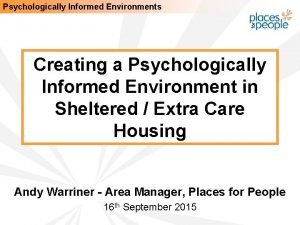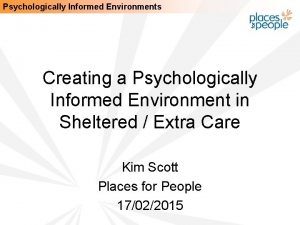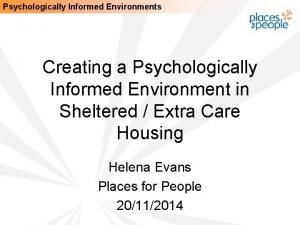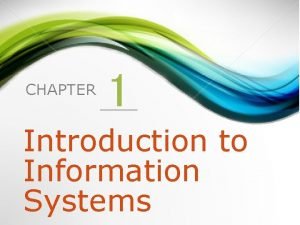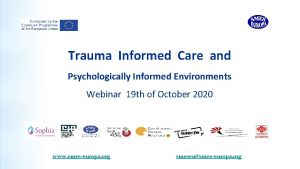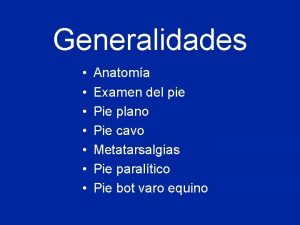IMPLEMENTING A PIE FRAMEW Implementing a Psychologically Informed







- Slides: 7

IMPLEMENTING A PIE FRAMEW Implementing a Psychologically Informed Environment (PIE) framework Clare Birch 1625 Independent People

IMPLEMENTING A PIE FRAMEWORK The starting point for 1625 ip’s journey could be located at numerous different points… For the purposes of this guide we have chosen 2010 which reflects the planning stage for Future 4 Me, the point at which we decided to write our ‘PIE’ down and the beginnings of where it became a ‘conscious’ framework for us as a charity. In thinking about a ‘starting point’, it’s important to acknowledge that this was not something miraculous that suddenly appeared in the charity, but brought together what we already knew and had as good practice with emerging thinking and good practice in this area. We expect this will be true for you as well

TIMELINE NARRATIVE 2010 - Beginnings of development – reflecting trend in wider homelessness services sector in becoming more’ psychologically informed’. Provided 1625 ip with opportunity to ‘formulise’ framework of provision 2012 – 1 st Draft of the first young people specific PIE framework looking specifically at Homeless YP, Future 4 Me starts, and linked to this our Reflective Practice Pilot (more about this later) and the introduction of PIE induction training (external delivery initially) 2014 – Reflective Practice rolled out across approx. 100 staff (facilitators trained to use peer facilitated model), PIE Induction training becomes internally led reflecting learning and ‘growing maturity as a PIE organisation, PIE Framework published (peer review), all managers trained as RP reflecting their role in RP groups & as line managers 2015 – further embedding PIE and thinking about how we can keep it alive and relevant for staff, developed PIE refresher training, PIE property reviews introduced. Learning framework reviewed

TIMELINE NARRATIVE 2016 - PIE 2 training – again thinking about how we can further embed and keep this alive, we set up PIE 2, an annual rolling programme of training covering different aspects of PIE in more detail. Examples include; INSERT 2017 - Development Reflective Practice groups, Future 4 Me 2 starts and the beginnings of the development of a National Toolkit for YP with experience of care and custody 2019 – PIE Development Coordinator (insert sentence about role), Development RP groups, Pilot of Acceptance and Commitment Therapy as the psychological framework for Reboot West, a specialist EET service for Care Leavers, PIE Framework reviewed and updated 2020 – Future 4 Me National Toolkit (care and custody leavers) published, pilot service specific approaches, Development of a multi-agency project to support RP delivery. Learning framework review; RP facilitators Support and development framework updated

CENTRAL PRINCIPLES A wide range of resources and guidance are available in relation to what a PIE framework might look like. Some organisations have based their work on other ‘generic’ frameworks and some have developed their own. We were keen to develop something that specifically reflected our work with Young People who are or are at risk of homelessness including care and custody leavers. Our original framework had 9 central aspects, in our current review this has reduced to 7 reflecting our learning about how we work with these in practice and the links between different aspects (2 original principles that were integrated are; ‘Graded sanctions’ - this became part of ‘Ownership, participation and decision making’ and ‘Psychological approaches’ and ‘Attachment trauma and trust’ were combined.

CENTRAL PRINCIPLES Things to think about: These 7 principles act as the golden thread through everything that we do – what would be the right principles for you? What would be the best way to link them which makes sense to colleagues? • Once you have your principles, what do you already have in place? • What do you need to develop / create? • What are ‘quick wins’? • What is the smallest actions that will create the most value? • What are the bigger projects that need more resourcing and time?

QUESTIONS? Thanks for listening
